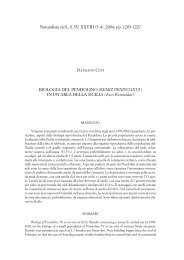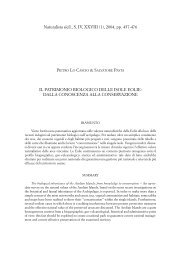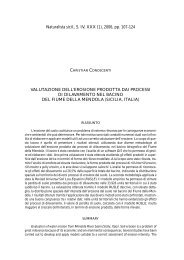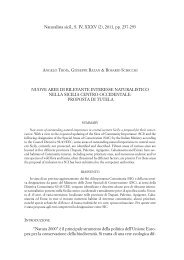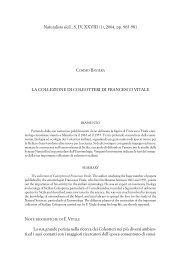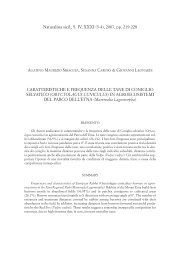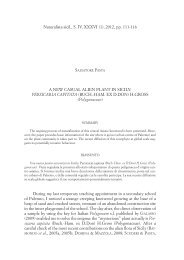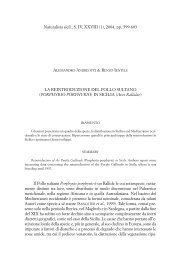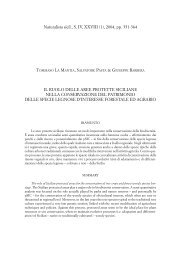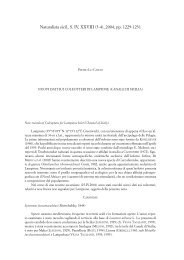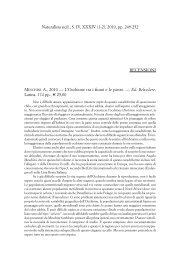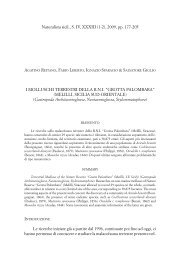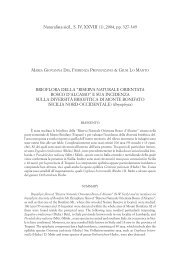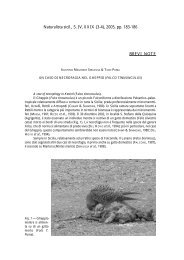2007,pp - Società Siciliana di Scienze Naturali
2007,pp - Società Siciliana di Scienze Naturali
2007,pp - Società Siciliana di Scienze Naturali
You also want an ePaper? Increase the reach of your titles
YUMPU automatically turns print PDFs into web optimized ePapers that Google loves.
290 M. SKUHRAVÁ, V. SKUHRAVY´ & B. MASSA<br />
or two larvae that pupate inside (Pl. IV, Fig. 22). Two generations develop per<br />
year. Occurrence: DE STEFANI (1903, 1906c) found galls in July on the Monti<br />
<strong>di</strong> S. Martino (Palermo) (600 m). Distribution: primarily Euro-Siberian<br />
species with <strong>di</strong>sjunct area. It has been imported to North America and New<br />
Zealand for biological control of Hypericum perforatum.<br />
UNIDENTIFIED SPECIES<br />
Galls of several gall midge species that were recorded on various host<br />
plants in Sicily need further research to ascertain which species is the causer.<br />
It is necessary to find galls once more at localities where they were found in<br />
the past, to preserve larvae in 75% alcohol for future examination and to try<br />
to rear adults to identify the causer. We arrange them in the following part<br />
alphabetically, accor<strong>di</strong>ng to the host plants.<br />
Atriplex halimus L.<br />
Galls of about 2 mm size, globulose, protru<strong>di</strong>ng on both leaf surfaces,<br />
caused by Cecidomyiidae, found at Santa Ninfa (Trapani). Reference: DE<br />
STEFANI jr (1942).<br />
Betula aetnensis Rafinesque<br />
Plemeliella sp. Reference: LONGO et al. (2001) recorded a species belonging<br />
to the genus Plemeliella on Etna without giving the description of the gall.<br />
Euphorbia s<strong>pp</strong>.<br />
Galls on Euphorbia bivonae, caused by Perrisia sp., found at “Favorita”,<br />
Palermo, in April; they are formed by 4-5 overla<strong>pp</strong>ed leaves, like a spindleshaped<br />
button, acutely en<strong>di</strong>ng, and contain <strong>di</strong>fferent yellow-red larvae. Reference:<br />
DE STEFANI (1905c).<br />
Galls similar to those above recorded, but containing withish larvae, found<br />
on Euphorbia ceratocarpa Ten., caused by an unidentified Cecidomyiidae, at<br />
Monti <strong>di</strong> Renda, in October and November. Reference: DE STEFANI (1907b).<br />
Galls on Euphorbia characias in the same locality and months, with the<br />
same characteristics of those found on E. bivonae above cited. Reference: DE<br />
STEFANI (1907b) wrote that larvae pupate inside a withish cocoon and galls<br />
are similar to those of Perrisia subpatula Bremi, with the only <strong>di</strong>fference that<br />
they are plurilocular.<br />
Lathyrus clymenum L.<br />
Rolled leaflets caused by Dasineura sp. (as Perrisia sp.). References: DE



